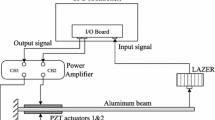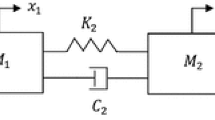Abstract
Active vibration control to suppress structural vibration of the flexible structure is investigated based on a new control strategy considering structure-actuator interaction. The experimental system consists of a clamped-free rectangular plate, a controller based on modal control switching, and a magnetostrictive actuator utilized for suppressing the vibrations induced by external excitation. For the flexible structure, its deformation caused by the external actuator will affect the active control effect. Thus interaction between structure and actuator is considered, and the interaction model based on magnetomechanical coupling is incorporated into the control system. Vibration reduction strategy has been performed resorting to the actuator in optimal position to suppress the specified modes using LQR (linear quadratic regulator) based on modal control switching. The experimental results demonstrate the effectiveness of the proposed methodology. Considering structure-actuator interaction (SAI) is a key procedure in controller design especially for flexible structures.
Similar content being viewed by others
References
L. Benassi, S. J. Elliott and P. Gardonio, Active vibration isolation using an inertial actuator with local force feedback control, Journal of Sound and Vibration, 276 (2004) 157–179.
I. Maciejewski and T. Krzyzynski, Method of selecting vibro-isolation properties of vibration reduction systems, Journal of Mechanical Science and Technology, 30 (4) (2016) 1497–1505.
S. B. Choi, Alleviation of chattering in flexible beam control via piezofilm actuator and sensor, AIAA J., 33 (1995) 564–567.
S. C. Mou, Structure design and stepping characteristics analysis of the biaxial piezoelectric actuator stage using a thin-disc piezoelectric actuator, Advances in Mechanical Engineering (2014) 1–16.
S. J. Moon et al., Structural vibration control using linear magnetostrictive actuators, Journal of Sound and Vibration, 302 (2007) 875–891.
Z. Butt et al., Generation of electrical energy using lead zirconate titanate (PZT-5A) piezoelectric material: Analytical, numerical and experimental verification, Journal of Mechanical Science and Technology, 30 (8) (2016) 3553–3558.
A. G. Olabi and A. Grunwald, Design and application of magnetostrictive materials, Materials and Design, 22 (2008) 469–483.
T. Zhang et al., Giant magnetostrictive actuators for active vibration control, Smart Material and Structures, 13 (2004) 473–477.
F. Braghin, S. Cinquemani and F. Resta, A model of magnetostrictive actuators for active vibration control, Sensors and Actuators A: Physical, 165 (2011) 342–350.
F. Braghin, S. Cinquemani and F. Resta, A low frequency magnetostrictive inertial actuator for vibration control, Sensors and Actuators A: Physical, 180 (2012) 67–74.
H. M. Zhou, X. J. Zheng and Y. H. Zhou, Active vibration control of nonlinear giant magnetostrictive actuators, Smart Materials and Structures, 15 (2006) 792–798.
M. J. Dapino et al., A coupled magnetomechanical model for magnetostrictive transducers and its application to Villari-effect sensors, Journal of Intelligent Material Systems and Structures, 13 (11) (2002) 737–747.
S. Valadkhan, K. Morris and A. Khajepour, Review and comparison of hysteresis models for magnetostrictive materials, Journal of Intelligent Material Systems and Structures, 20 (2) (2009) 131–142.
M. J. Dapino et al., A coupled structural-magnetic strain and stress model for magnetostrictive transducers, Journal of Intelligent Material Systems and Structures, 11 (2000) 135–151.
M. J. Dapino, R. C. Smith and A. B. Flatau, Structuralmagnetic strain model for magnetostrictive transducers, IEEE Transactions on Magnetics, 36 (3) (2000) 545–556.
J. P. Lien et al., Modeling piezoelectric actuators with hysteretic recurrent neural networks, Sensors and Actuators A, 163 (2) (2010) 516–525.
W. S. Oates and R. C. Smith, Nonlinear optimal control techniques for vibration attenuation using magnetostrictive actuators, Journal of lntelligent Material Systems and Structures, 19 (2) (2008) 193–209.
M. A. Janaideh, S. Rakheja and C. Y. Su, A generalized Prandtl-Ishlinskii model for characterizing the hysteresis and saturation non linearities of smart actuators, Smart Materials and Structures, 18 (4) (2009) 1–9.
J. Mao and H. Ding, Intelligent modeling and control for nonlinear systems with rate-dependent hysteresis, Science in China, 52 (4) (2009) 656–673.
X. Chen, T. Hisayama and C. Y. Su, Pseudo-inverse-based adaptive control for uncertain discrete time systems preceded by hysteresis, Automatica, 45 (2) (2009) 469–476.
P. Liu, Z. Zhang and J. Q. Mao, Modeling and control for giant magnetostrictive actuator with rate-dependent hysteresis, Journal of Applied Mathematics (2013) 1–8.
O. Aljanaideh, S. Rakheja and C. Y. Su, Experimental characterization and modeling of rate-dependent asymmetric hysteresis of magnetostrictive actuators, Smart Materials and Structures, 23 (2014) 1–12.
J. Liu, J. H. Liu and S. J. Dyke, Control-structure interaction for micro-vibration structural control, Smart Materials and Structures, Doi: https://doi.org/10.1088/0964-1726/21/10/105021.
Author information
Authors and Affiliations
Corresponding author
Additional information
Recommended by Associate Editor Gyuhae Park
Jinjun Jiang received the B.E., M.E. degrees in Mechanical Engineering and automatization from Hebei Engineering University in 2006 and 2009. From 2017 to 2018 he has been to New York University as a visiting scholar in Mechanical Engineering and Complex Network Control. Since 2009, he has been an engineer and researcher in China Aerospace Aerodynamics Academy. He is the author of more than 10 articles and holds more than 10 inventions patents. His research mainly focuses on mechatronics Control Technology, Complex Network, Industry Robot Control, Vibration Control Technology robotic structure and control, and human-machine system.
Weijin Gao received the Ph.D. in mechatronics engineering from Beihang University. Since 2016, he has been an engineer and researcher in China Aerospace Aerodynamics Academy. His research interests include dynamic topology optimization and active vibration control. He is the author of ten articles and holds three inventions patents.
Rights and permissions
About this article
Cite this article
Jiang, J., Gao, W., Wang, L. et al. Active vibration control based on modal controller considering structure-actuator interaction. J Mech Sci Technol 32, 3515–3521 (2018). https://doi.org/10.1007/s12206-018-0702-y
Received:
Revised:
Accepted:
Published:
Issue Date:
DOI: https://doi.org/10.1007/s12206-018-0702-y




